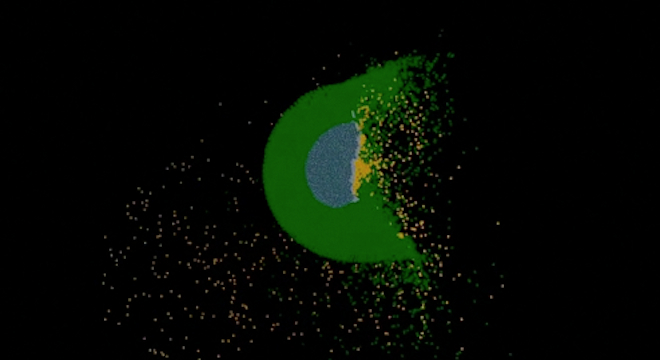Updated 11:21 .am. EDT, Thursday, October 18
The Earth and the Moon have always been close in astronomical terms, but now a newly proposed theory from Harvard planetary scientists suggets that they may be more like family.
A really violent family, that is, considering the new theory states that a planetary body half the size of Mars struck Earth moving at a speed of 12-miles-per second, instantly vaporizing but cleaving off a huge chunk of our home planet down to its core and dispersing it into space, and that this material is what coalesced to form the Moon.
The new theory, proposed by Harvard planetary science professor Sarah T. Stewart and Matija Äuk, a Harvard postdoc and principal investigator at SETI and published in a paper in the journal Science on Wednesday, is actually is itself a combination and tweaking of two other theories — the “giant impact hypothesis” and the “fission hypothesis,” neither of which alone satisfactorily explained how the moon first appeared in Earth’s sky billions of years ago.
Check out the following Harvard video simulation of the new theory of the Moon’s formation, showing the Earth in green getting smacked by a planetary body in yellow:
“The entire surface of the Earth is boiling after the impact,” Stewart told TPM via email, “The entire surface of the Earth was deformed/disrupted/vaporized.”
The “giant impact hypothesis,” the previous leading theory behind the Moon’s formation, suggests that a giant, Mars-sized object known as Theia smacked into the Earth over 4.5 billion years ago and broke apart, and that the resulting debris from both the Earth and Theia formed the moon.
But that theory has a few big problems, including the fact that the impactor, Theia, should be responsible for the majority of the Moon’s current composition.
It’s not — in fact, the Moon is much more like Earth (they have nearly identical isotopic signatures, that is, the molecular formations of elements such as silicon, chromium, tungsten and oxygen are similar on both bodies).
So Harvard researchers have tweaked that theory and combining it with another known as the “fission hypothesis,” which states that a part of the Earth’s own crust broke off and drifted away to form the moon.
The “fission hypothesis,” first proposed in 1879 by George H. Darwin, son of revered naturalist Charles Darwin, also has issues of its own. Namely, it requires that the Earth would have been spinning much faster than than it does presently, for which Darwin (the son) had no compelling explanation.
But Stewart and Äuk can now account for this as well: In their model, the Earth was spinning much more rapidly, such that a “day” at the time of the Moon’s formation was just two or three hours long. This would mean that the composition of the Earth itself was already highly unstable, approaching the point at which it would break apart on its own and with a much more “squished” shape resembling a football, due to the massive rotational forces.
When the planetary aggressor Theia struck the Earth, according to their model, it sends a disk of material spinning out around Earth’s orbit. But then, over hundreds of years, the disk cooled to form the Moon. At this point, the Moon’s own orbit began to expand outward, away from the Earth. Over the course of another ten thousand years, the Earth transfered angular momentum to the moon, slowing down Earth’s spin. During this phase, the Moon would have appeared about 20 times larger in the night sky, according to the scientists.
“In our simulations, the initial Earth is a little larger than today (e.g., 5% more mass), which is lost in the impact,” Stewart told TPM. “The disk is about twice the mass of the Moon — half the mass goes into the Moon and half into the Earth.”
Updated to add comments from Stewart to TPM in copy.






